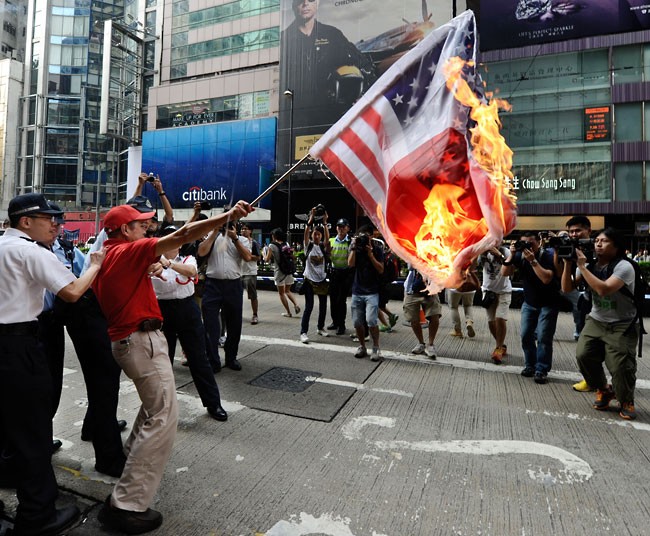NATO anno 2014
In 2014, it is fair to say regarding the post-cold war transformation that the operation succeeded, but the patient still remains in pain. The newly emerged challenges in Ukraine, Iraq and Syria combined with NATO’s hesitating attempts to resolve these has shown that the transformation has had a price, and that the price might turn out to be higher than expected. Some academics would go as far as to say that NATO is threatened in its very existence. That is not necessarily the case. NATO may be struggling, but it is definitely not yet dying.
Caught up between Kiev and the Kremlin
For NATO the Ukraine crisis is a difficult one. On the one hand, there are good reasons not to escalate conflict with Russia since the worst-case scenario could turn nuclear. But on the other hand, the values of the Alliance are under great pressure, and not intervening in Ukraine could tempt Russia or other regional adversaries to make a similar strategic move towards another country.
Russia seems to be willing to tear Ukraine apart in order to prevent the North Atlantic Alliance from expanding. Without Russia’s consent it is impossible to stabilize Ukraine as the Kremlin definitely has leverage.
Ukraine is not a NATO member state; therefore NATO has no article 5 obligation to protect the country against a foreign aggressor. It seems that NATO instead has chosen the least risky compromising solution in Ukraine by following a sufficiently half-hearted deterrence strategy enforced by a readiness action plan to keep Russia from making a similar move elsewhere. It is crucial for NATO not to be forced into an Article 5 situation in Europe, and therefore it is buying itself time in Ukraine to figure out a more long-term strategy towards Russia. This could result in accepting a frozen conflict in Ukraine, leaving the country divided.

© Sasha Maksymenko. January 2014: A barricade during the riot in Kiev.
An echo from ISAF
NATO plays no significant role in the coalition against ISIL, though several of the coalition-members are NATO members. There are three main reasons why NATO hesitates to take the lead in the battle against ISIL. First: the lessons learned from Afghanistan; second: the ambivalent relationship inside NATO towards out-of-area operations; and third: the missing perception of ISIL as a vital threat.
The lessons learned from ISAF are that when dealing with intervention in failed states there are no guarantees for success or easy exits, and the costs are immense. No country within the Alliance has any interest in deploying soldiers to an out-of-area operation again. Instead NATO wants to delegate part of the responsibility to regional partners in the fight against terrorism. This way the Alliance can be leading from behind.
Inside NATO the questionable results of the intervention in Afghanistan has increased the discussion about the entire “out-of-area” aspect. Many European members doubt if “out-of-area” operations can ever be worth the costs. And even if they could, does it mean that NATO should intervene? Regionalists and globalists within NATO do not agree on the degree to which the Alliance should be concentrated towards regional or global challenges.
Unless a NATO member is attacked on its own territory, chances are few that NATO will engage itself further into the battle against ISIL. However if an ally is attacked by ISIL the discussion should change substantially since NATO then will be facing an Article 5 situation demanding a proper response. One could also argue that this underlines that ISIL is not making an existential threat to NATO, and many NATO members do not perceive ISIL as a vital threat

© U.S. Department of Defence. European countries support the US bilaterally in Operation Inherent Resolve.
The Necessary Balance Within NATO
NATO is and needs to be both a regional and global actor. It does not have the luxury to choose between the two. Both aspects are also crucial to the internal dynamics that keep the transatlantic bond intact. Europe needs the U.S. in order to make credible commitments about European security and the U.S. needs Europe as an ally in its ambitious quest for keeping its world order the only legitimate game in town. This serves as a strong argument for the continuing interdependence. This is also why members linked collective defense with global crisis management at the Cardiff Summit back in September. The coalition against ISIL was formed, at the same time Europe was promised a tip of the spear force to stand guard at eastern borders.

© NATO. November 2014: The Secretary General Jens Stoltenberg at the Parliamentary Assembly in The Hague.
Conclusion
NATO is not in the middle of a life-threatening crisis. What in 2014 could make one doubt NATO’s future role for North Atlantic security is more a reflection of its success: there are no true challengers around and that opens the door for diversity within. There are no major threats to North Atlantic security. But this does not necessarily mean NATO is safe. There is something paradoxical about not facing existential threats, NATO might become its own worst enemy and potentially tear itself apart from the inside, if the informal contract between North America and Europe is not kept intact. That means even though the external challenges might not be life threatening, we should still pay great attention to NATO’s internal responses since they seem to be key to understanding NATO’s only potential life threatening challenge in 2014.
About the author
Written by Jeppe Damgaard Rothuizen student at Aarhus University and intern at The Danish Atlantic Treaty Association (www.atlant.dk).
Disclaimer:
Any views or opinions expressed in this article are solely those of the authors and the news agencies and do not necessarily represent those of the NATO Council of Canada. This article is published for information purposes only.



